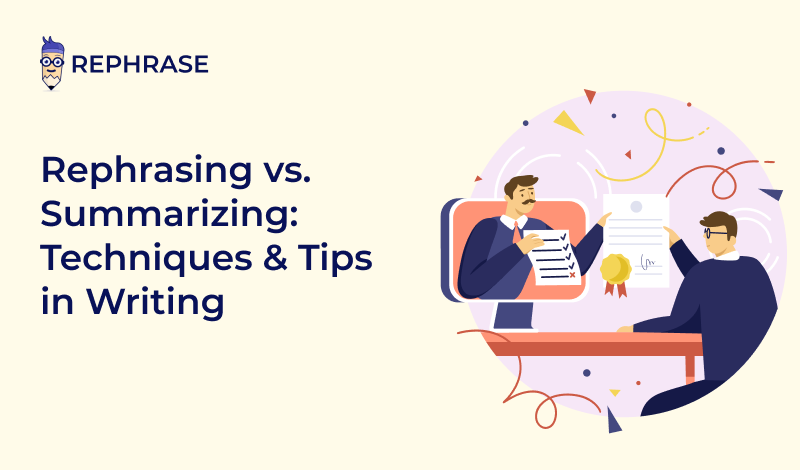
Rephrasing vs. Summarizing: Techniques & Tips in Writing
Writing is one of the hardest skills to master. It requires a complete understanding of numerous approaches, strategies, and tactics. Two of the most common ones are rephrasing and summarizing.
Rephrasing and summarizing are two useful techniques that make it easier for people to traverse the writing world. These two methods are connected. Therefore, mastering one necessitates the understanding of the other. This interconnectedness often puzzles beginners. As a result, they start using summarizing and rephrasing interchangeably. If you are confused, this place will help you clarify it.
In this blog content, we’ll go over the basic concept, goal, and tips required to master both rephrasing and summarizing. To understand the differences between these two writing approaches easily, we’ll conduct a head-to-head comparison here. So, let’s delve in without any further delay.
The Core Concepts of Rephrasing and Summarizing
To compare them more effectively, it is important to grasp the fundamental ideas behind both rephrasing and summarizing. So, let’s begin by rephrasing before proceeding to summarize.
Rephrasing
The word ‘rephrase’ combines two words: ‘re’ and ‘phrase.’ Since ‘re’ means ‘to do something again,’ this writing strategy revolves around restating current information while avoiding plagiarism. That information can consist of one or many phrases and paragraphs.
Rephrasing is only successful when the rephrased text is not identical to its original form. Therefore, to rephrase something, you must use your knowledge to modify the words and sentences. Otherwise, it will be impossible for you to prevent plagiarism while revamping existing content.
Summarizing
‘Summarizing’ originates from the term: ‘sum up.’ Therefore, this writing technique provides an overview or synopsis of existing data. That data can be a passage from a book, a movie, a real-life event, etc.
Much like rephrasing, summarizing requires a thorough knowledge of the original information. Plus, utilizing your wording when delivering an abstract or brief of existing info is critical. This way, you won’t overlook important facts or fall prey to plagiarism.
Tips of the Trade to Master Summarizing and Rephrasing
You may have realized by now that implementing both summarizing and rephrasing necessitates a thorough comprehension of the original material. So, before proceeding to the tips listed below, be sure you understand the information you wish to rephrase or summarize to the point where you can describe it without referring to it directly. But if that’s not the case, the following suggestions will be useless:
How to Rephrase a Piece of Information?
To rephrase a piece of information, you can:
- Use contextually correct synonyms.
- Change word classes.
- Tweak the sentence structures.
After applying these tips, you need to verify:
- If the rephrased version conveys the same meaning.
- Whether the rephrased form looks unique.
But if that’s not the case, you must implement the tips mentioned above again. You can also utilize our AI rephraser. The tool uses cutting-edge machine-learning models and language-processing algorithms to automate the process. Besides rephrasing, our AI-powered rephrase tool can also make the text clearer or more appropriate for a particular audience without altering the original message. So, if you can’t rephrase something alone, you can consider using technology.
How to Summarize Something?
To summarize something, you need to:
- Focus on the key ideas.
- Discard all the unnecessary details.
- Use your writing style.
After implementing these recommendations, review the created summary. If you cannot understand the same idea that the original (source) variant delivers, you will have to repeat the summarizing process.
You can also leverage our AI summarizing utility, as it relies on combining hybrid (abstractive and extractive) summarization approaches and artificial intelligence. This fusion helps our tool summarize any text that has been entered efficiently. So, if you can’t summarize something alone, consider using our AI-based text summarizer.
Samples Demonstrating the Instances of a Perfectly Rephrased and Summarized Text
To better understand the comparison of summarizing and rephrasing, let’s consider the following source text:
The elegant brown fox leaps over the lazy dog to keep up with its buddies who have already passed over.
Rephrased Form: The swift brown fox jumps over the slow dog because it is trying to catch up with its friends who have already crossed to the other side.
Summarized Form: A fox leaps over a lethargic dog to join its companions.
As you can see, the source text is difficult to read and comprehend. However, both the rephrased and summarized forms have elevated the readability of the same text without altering the original meaning.
Summarizing Vs. Rephrasing — The Key Differences
Rephrasing and summarizing can enhance understanding of an existing piece of information. However, there are some key differences between these two writing techniques. The points below represent those differences:
Scope
Experts usually use summarization to convey broader concepts and comprehensive overviews of books, chapters, or papers.
Rephrasing, on the other hand, is suitable for unique details and specific topics.
Length
Summaries are always briefer and more condensed than the original variant.
However, rephrased pieces of content have around the same length as the original version.
Wrapping Up
To sum up, rephrasing and summarizing both call for demonstrating your understanding of the original content. Therefore, the wording used in the rephrased and summarized content must not be identical to that of the original. Plus, both approaches require proper source citations. Otherwise, plagiarism can become a problem for you. However, summarizing and rephrasing are two distinct strategies. When summarizing anything, you need to elaborate on the most important details in your own words. But there is no such requirement in rephrasing. This technique depends entirely on using your words to convey an already-existing idea while maintaining the original meaning. So, after reading this blog post, we hope you will no longer be confused between these two writing concepts.

